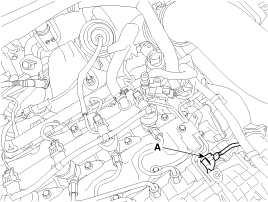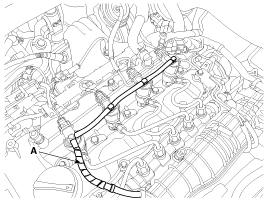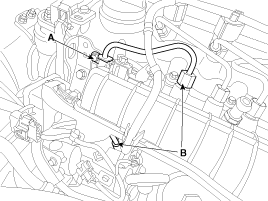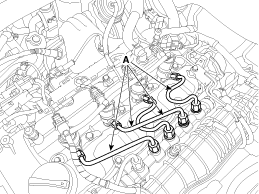Disconnect the rail pressure sensor connector (A).

Common Rail Fuel Injection System operates with extremely high pressure (approximately 1,600bar), so never perform any work on injection system with engine running or within 30 seconds after the engine stops.
Keep cleanly the parts and the working area.
Pay attention to a foreign substance.
Just before installing injector, tube or hose, remove the protect-cap attached on them.
Do not remove injector except for special case.
When installing Injector
- Wash the contact area of the injector and replace the O-ring with a new one. - Spread oil on the injector O-ring. - To protect damage caused by shock, vertically insert the injector into the cylinder head. |
When installing High Pressure Fuel Pipe
- Do not use again the used high pressure fuel pipe. - Install the flange nut correctly. |
Turn ignition switch OFF and disconnect the battery negative (-) battery terminal.
Disconnect the rail pressure sensor connector (A).

Disconnect the fuel return line (A) from the injector.

Disconnect the high pressure fuel pipe flange nut (B) after loosening the clamp mounting bolt (A).
Remove the high pressure fuel pipe.
High pressure fuel pipe clamp mounting blot:
6.8 ~ 10.7 N.m (0.7 ~ 1.1 kgf.m, 5.1 ~ 8.0 lb-ft)
High pressure fuel pipe flange nut:
24.5 ~ 28.4 N.m (2.5 ~ 2.9 kgf.m, 18.1 ~ 21.0 lb-ft)

Remove the high pressure fuel pipe (A).
High pressure fuel pipe flange nut:
24.5 ~ 28.4 N.m (2.5 ~ 2.9 kgf.m, 18.1 ~ 21.0 lb-ft)

Remove the intank Intake Manifold.
(Refer to Engine Mechanical System -"Intake Manifold")
Remove the common rail after loosening the mounting bolts (A).
Common rail mounting bolt:
14.7 ~ 21.6 N.m (1.5 ~ 2.2 kgf.m, 10.9 ~ 15.9 lb-ft)
